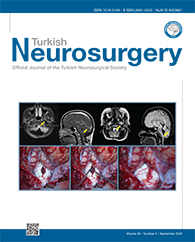2Cukurova University Medical Faculty, Department of Neurosurgery, Adana, Turkey
3Adana City Training and Research Hospital, Department of Anesthesiology and Intensive Care, Adana, Turkey DOI : 10.5137/1019-5149.JTN.31207-20.2 AIM: To evaluate surgical treatment options, complications and neurological outcomes of patients with cavernous malformations (CMs) in the pons and medulla oblongata.
MATERIAL and METHODS: We retrospectively evaluated 25 brain stem CMs that we operated between 2009 and 2019. We operated all cases in the first month with suboccipital retrosigmoid and paramedian approach. The cases were evaluated concerning their demographic characteristics, lesion characteristics, radiological imaging results, surgical approach and neurological status.
RESULTS: Overall, 15 patients had CMs in the pons and 10 in the medulla oblongata. The mean age of the patients was 33.48 years, and the cases included 15 male and 10 female patients. The average modified Rankin Score (mRS) score had a mean of 2.36 and median of 2 at the time of admission (Table I). The mean follow-up period was 4.64 years (1?10 years). In the last follow-up assessment, the average mRS score was mean = 1.84 and median = 1. In addition, 14 (56%) patients recovered, 7 (28%) did not show any changes, 3 (12%) got worse, and 1 (4%) died. In our case series, the admission complaints were cranial nerve paralysis (24%) in 6 cases, nausea and vomiting in 1 (4%) and hemiparesis in 17 (68%).
CONCLUSION: Experience, correct surgical approach and good knowledge of neuroanatomy are important in brainstem CM haemorrhages. Imaging methods, neuronavigation and neuromonitoring use are essential for patients undergoing surgery. In the presence of all these factors, the prognosis of patients will be better.
Keywords : Brainstem, Cavernomas, Surgery, Bleeding




